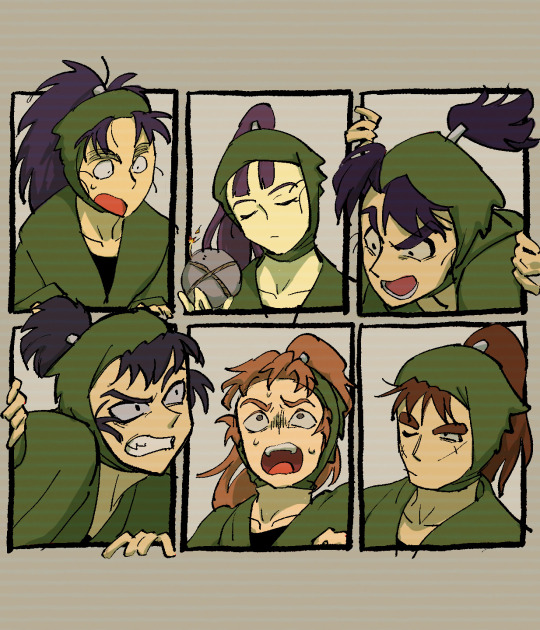#六文
Explore tagged Tumblr posts
Text

自機組の方々です!
#射命丸文#チルノ#東風谷早苗#鈴仙・優曇華院・イナバ#霧雨魔理沙#博麗霊夢#十六夜咲夜#魂魄妖夢#aya shameimaru#cirno#sanae kochiya#reisen udongein inaba#marisa kirisame#reimu hakurei#sakuya izayoi#youmu konpaku#東方Project#touhou
422 notes
·
View notes
Text










“哥哥好雅致”
少女的声音响起的那一刻,我被吓到差点从椅子上跌落。好不容易站稳脚跟,我的心脏剧烈地跳动:因为我的双手已经被反绑在身后,教唆已经套在脖子上,一个差错,便有可能导致我当场被绞死!
“其实,我看到哥哥把自己吊起来的全过程,还录像了哦!哥哥要不要看看自己是怎么样的形象呢?”我拼命摇头,想让少女走开;因为我此时一丝不挂,勃起的阴茎已然完全暴露。
“要不要,我帮哥哥添一把火呢?哥哥放心~我不会把你的秘密说给别人的”
她绕到我面前,撩起衣服,露出文胸下丰满的乳房:“怎么样,哥哥喜欢吗?”
我没有再扭过身体躲闪她;相反,我被她吸引住目光,连遮掩自己的羞耻都忘记了。“哥哥喜欢就最好啦!”少女继续脱下自己的衣服,直到一丝不挂。我的阴茎伴随着少女衣服的一层层褪去而愈发勃起坚挺,到她全裸的那一刻,已经令我感到胀痛。
“哥哥,要我帮你高潮吗?”少女走近来,用手指刮蹭我的阴茎:“我的脚能帮哥哥感受到极乐哦~不会浪费你的时间的!”
不等我同意,她已脱下皮鞋,将黑丝包裹的足尖踩在我的龟头上。果然如她所说,我在短短一分钟内便向她交出了所有的精液。
“那么,哥哥,准备接受惩罚吧~我说过,我不会把你的秘密透露出去,可是,我该怎么保证你不会透露我的秘密呢?”
“哥哥晚安,愿你下辈子做个好人~”
说罢,少女踢掉了我脚下的凳子。
我在极度痛苦去羞辱中痛苦挣扎,勃起的阴茎完全展示给少女。她盯着我的裸体的抽搐,手伸进内裤抚慰着自己,很快,她的内裤便被淫液浸透。
此时,我已精疲力竭,此前的射精消耗了太多力气,我只挣扎了几分钟,便静静吊在绞索下,绝望地等待死亡的降临。
“哥哥,这是奖励你的哟”少女的手指伸进我的口中,叫我品尝她私处的味道。受此刺激,我又射出了最后几滴精液,顺着阴茎向下流淌,沾染在阴囊上。
最后一次揉捏我的乳头和阴茎,确认我的死亡后,少女穿回衣服,唯独留下湿透的内裤塞进我的嘴��,然后转身离去。而我的裸尸,将被长久地悬吊在那里,等待有人发现我射精的耻辱,或是直到化为灰尘...
24 notes
·
View notes
Text
刺青 文身 東大阪 彫聖




大阪 世墨文身 東大阪 彫聖

22 notes
·
View notes
Text

夏の趣き
2014年、六本木。
金魚の団扇に簾。巻き上げられた簾には夏の日があたる。
この場所を確認するのに難儀した。この店や周辺の建物はずいぶん建て替えが進んだようだ。
#Lightroom Classic#VSCOfilm#photographers on tumblr#lensblr#original photographer#original photographers#original photographers on tumblr#original photography#original photography blog#original photography on tumblr#photoblog#photography#summer#summer season#summer season in Japan#summer season mood#summer season time#summer season tint#July#Japan#Tokyo#文月#日本#東京#六本木#うちわ#団扇#round fan#すだれ#簾
56 notes
·
View notes
Text

#我经常七点起床(按止闹按钮半小时后);明天是星期六,所以我打算七点半起床。我不能太晚起床,否则有工作的时候不习惯早起床可能会迟到#journaling#journaling prompts#journaling in chinese#chinese language#langblr#chinese langblr#mandarin#中文#日记本
18 notes
·
View notes
Text

地下文学の世界 秘蔵文庫 第六巻 地下文学研究会編 壱番館書房 情慾の世界/坩堝はたぎる 他
9 notes
·
View notes
Text

❇️
8 notes
·
View notes
Text

38 notes
·
View notes
Text

#oc#オリジナル#柚愛一滋緒#八奈見マチ#林陽路子#カミラ・ナフカ#奇野とうか#不死川憑子#不死川多生#鼈甲万文#鼈甲勉学#ユリアン・ヴリール・オールド#島津巳士郎#鬼丸鏡子#十六夜香月#一風いをい#千田夕鶴
3 notes
·
View notes
Text










2 notes
·
View notes
Text
【自機組】
#魂魄妖夢#youmu konpaku#鈴仙・優曇華院・イナバ#reisen udongein inaba#十六夜咲夜#sakuya izayoi#チルノ#cirno#射命丸文#aya shameimaru#東風谷早苗#sanae kochiya#霧雨魔理沙#marisa kirisame#博麗霊夢#reimu hakurei
305 notes
·
View notes
Text


描けば出る。
でも、鍛刀運/zeroなので、孫六さん来てくれないかもしれない。
7 notes
·
View notes
Text
刺青 和彫り 古典

歪んだものほど美しい 2015年11月4日 · ·
ブリ庄さん
背:迦陵頻伽(筋:彫五郎 ぼかし:初代彫文)
腹:雷神(初代彫文)
「原色日本刺青大鑑」 芳賀書店・刊 (1973年)より
#かいな#腹#背#japanese traditional art#刺青#和彫り#japanese tattoo#和彫り古典#刺青古典#ふんどし#褌#六尺褌#fundoshi#loincloth#彫五郎#初代彫文
21 notes
·
View notes
Text
彭麗媛和中共七常委的「六四」故事
1989年4月,在進入經濟改革十年後,中國出現了要求政治自由化的呼聲。而後,天安門廣場爆發了抗議活動,震動了共產黨。最終,6月4日士兵和坦克車大舉進入北京,眾多赤手空拳的抗議者和旁觀者在大屠殺中死亡……,而官方稱,「天安門廣場沒開一槍,沒死一人。」 類似的謊言,在中共的歷史上,之前有,之後也有。許多明知事實而裝傻的人,混在官場和商界,後來成為紅朝的新權貴。 中共七常委的「六四」時間 善良的人們一直希望中共「平反六四」,但看看中南海高層的更替,在當下習近平主導的中共政治中,看不到任何與「平反六四」相關的可能。現中共高層這批人在「六四」當年的表現,早已注定這一切。 「六四」期間,習近平正主政福建省寧德地區。據官媒披露,習當時積極配合中共中央,阻止了浙江溫州學生跨省到福建搞串聯。第二年,習近平就升為福州市委書記。 習近平當時批示道:「第一要認定中央、跟定中央,一切聽從黨中央指揮;第二…

View On WordPress
5 notes
·
View notes
Text



2023年12月4日(月)
鯰江六太夫の墓は分からないとのこと・・・
壱弐参横丁の「よもぎ」初訪問
4 notes
·
View notes
Text

地下文学の世界 秘蔵文庫 第十六巻 地下文学研究会編 壱番館書房 花ひらく/鬼あざみ 他
5 notes
·
View notes